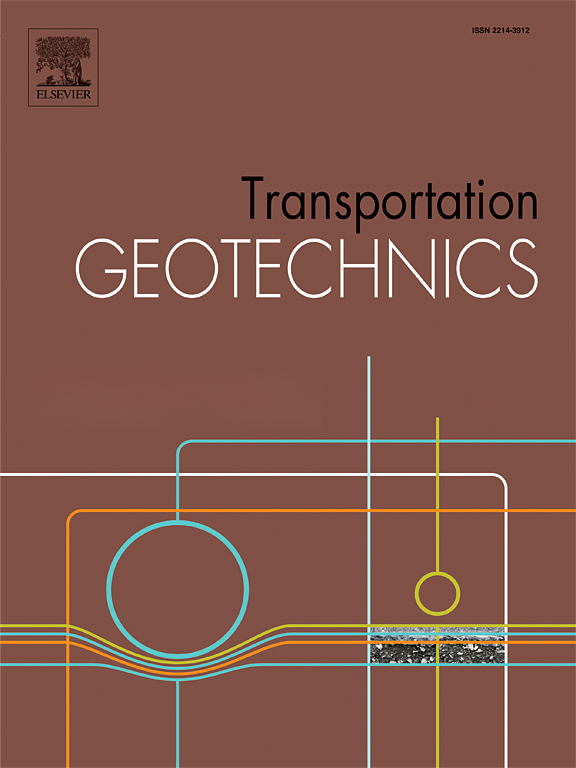Failure mechanisms and characteristics of high-filled embankments with different types of basal reinforcement
IF 4.9
2区 工程技术
Q1 ENGINEERING, CIVIL
引用次数: 0
Abstract
The accurate evaluation of the failure mechanisms and characteristics of high-filled embankments reinforced by different basal reinforcements is essential for ensuring the safety of transportation infrastructure. This study conducted two centrifuge tests to investigate the failure mechanisms and characteristics of high-filled embankments reinforced by a geosynthetic and a concrete slab, respectively. The particle image velocimetry (PIV) technique was used to observe the initiation and progression mechanisms in the soft layer. The test results reveal that the geosynthetic-reinforced embankment exhibited a progressive shear failure mechanism and the soft layer exhibited strain-softening characteristics, while the embankment reinforced by the concrete slab exhibited instantaneous shear failure in a soft foundation. Based on numerical analysis, the relationship between the overall stability and the failure modes of the reinforced embankment system was revealed. The stiffness and layers of the basal reinforcements both had positive influence on the embankment stability when deep-seated rotational failure occurred. For embankment fills with low shear strength, employing a concrete slab as basal reinforcement led to general slope failure, and the global stability was determined by the shear strength of the embankment fill. The findings of this study may be useful for the design of transportation infrastructure.
不同地基加筋类型高填土路堤破坏机理及特征
准确评价不同地基加固方式的高填土路堤的破坏机制和特征,对于保障交通基础设施的安全至关重要。本研究进行了两次离心试验,分别研究了土工合成材料和混凝土板加筋的高填土路堤的破坏机制和特征。采用粒子图像测速(PIV)技术观察了软层中的起裂和进展机制。试验结果表明,土工合成材料加筋路堤在软基上表现为渐进剪切破坏机制,软基层表现为应变软化特征,而混凝土板加筋路堤在软基上表现为瞬时剪切破坏。通过数值分析,揭示了加筋路堤体系整体稳定性与破坏模式之间的关系。基底加筋的刚度和层数对路基发生深部旋转破坏时的稳定性均有正向影响。对于抗剪强度较低的路堤填方,采用混凝土板作基础加固导致边坡整体失稳,整体稳定性由路堤填方抗剪强度决定。本研究结果可为交通基础设施的设计提供参考。
本文章由计算机程序翻译,如有差异,请以英文原文为准。
求助全文
约1分钟内获得全文
求助全文
来源期刊

Transportation Geotechnics
Social Sciences-Transportation
CiteScore
8.10
自引率
11.30%
发文量
194
审稿时长
51 days
期刊介绍:
Transportation Geotechnics is a journal dedicated to publishing high-quality, theoretical, and applied papers that cover all facets of geotechnics for transportation infrastructure such as roads, highways, railways, underground railways, airfields, and waterways. The journal places a special emphasis on case studies that present original work relevant to the sustainable construction of transportation infrastructure. The scope of topics it addresses includes the geotechnical properties of geomaterials for sustainable and rational design and construction, the behavior of compacted and stabilized geomaterials, the use of geosynthetics and reinforcement in constructed layers and interlayers, ground improvement and slope stability for transportation infrastructures, compaction technology and management, maintenance technology, the impact of climate, embankments for highways and high-speed trains, transition zones, dredging, underwater geotechnics for infrastructure purposes, and the modeling of multi-layered structures and supporting ground under dynamic and repeated loads.
 求助内容:
求助内容: 应助结果提醒方式:
应助结果提醒方式:


